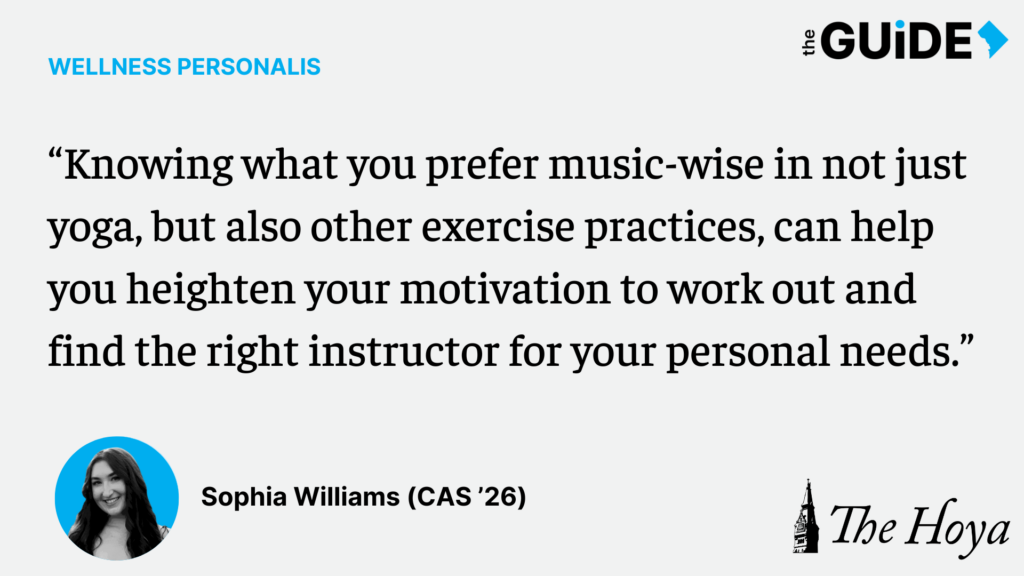It’s 7 a.m., Saturday morning. You lie defeated, exhausted in your bed, helpless as Cooper Field blasts pop hit after pop hit. Ultimately, you give up trying to fall back asleep — but not without a blaze of annoyance directed at the music cranked to maximum volume hours before the football or lacrosse game in question.
Don’t get me wrong: I love listening to music whenever I can, but I don’t particularly love hearing it when I haven’t gotten my eight golden hours of sleep. I assume I’m not the only one to have had this experience, so I decided to ask why.
I wondered if the loud music had a special function, like enhancing athletic abilities. As it turns out, music can enhance a workout by improving your stamina. Music can both keep your muscles from fatiguing and increase your workout productivity.
Synchronizing your pace with the tempo of a song can help you travel for a longer distance at a faster pace or complete more repetitions. Reflecting on my own experiences, this revelation makes sense: I often find myself subconsciously matching my playlists’ tempo when running or doing yoga.
Now, you can consciously take full advantage of this instinctive ability to match a song’s tempo. For example, to maximize your stamina and push your fitness limits for each activity, you can build playlists of varying BPMs. BPM, or beats per minute, is the number of beats in a minute of each song — essentially, the speed of the song.
A 2014 study indicates that the most effective BPM for treadmill workouts ranges from 123 to 131 BPM and from 125 to 140 BPM for cycling. In case you (understandably) don’t want to count out each song’s BPM manually, you can find pre-made playlists with songs with specific BPMs! I searched Spotify for “125 bpm” and received tons of results.
I realize that I’m not the only one seeking to take advantage of music as a hack to enhance my fitness or, at least, motivation — hence the pump-up playlist preceding every game on Cooper Field.
All this about music’s fitness-enhancing benefits made me question whether the reverse is true: does a lack of music diminish fitness ability?
I recently attended a Flow for $10 at Down Dog Yoga. Besides the fact that I did not adequately prepare myself for the extreme heat level (in terms of both mental state and hydration level), I found yoga without music extremely difficult.
I rely on music to distract myself from my muscle fatigue, allowing me to sink deeper into a pose. Without music and with the heat, I had no desire to sink deeper into a pose. In fact, my only desires were to drink water and leave. Yet, I stayed. I figured the studio intended the absence of music, and I felt determined to know why and to discover the effects of my practice.
I discovered Down Dog Yoga teachers (and students) practice Baptiste Power Vinyasa Yoga. Baron Baptiste, who founded this practice, advocates the use of music as a spiritual and energetic tool. However, critics of using music in yoga argue that music can distract students from their inward reflection and focus. Some find it difficult to focus on an instructor’s words with the added stimulus of music.
Knowing what you prefer music-wise in not just yoga, but also other exercise practices, can help you heighten your motivation to work out and find the right instructor for your personal needs. It is critical to understand whether you want to prioritize internal reflection or heighten your fitness by matching the BPM of your favorite songs, keeping in mind that your preferences may differ depending on the kind of activity you are doing.
So, maybe next time you awaken to blaring music from our dear Cooper Field, you’ll be more likely to support your fellow Hoyas as they use music to motivate them to win! Or, maybe you’ll want to destroy the speakers so you can have some quality internal reflection. No matter what, take your newfound knowledge about music to help you elevate your fitness goals.
Now, only if we could get rid of that air horn…
Sophia Williams is a first-year in the College of Arts & Sciences. Wellness Personalis will appear online and in print every three weeks.














